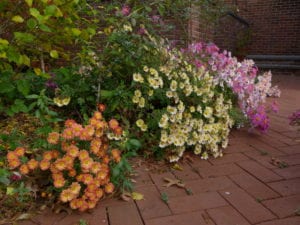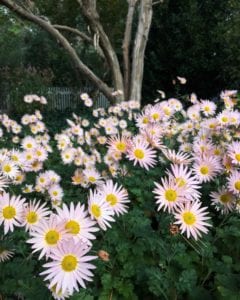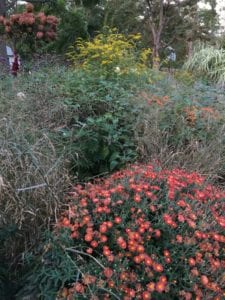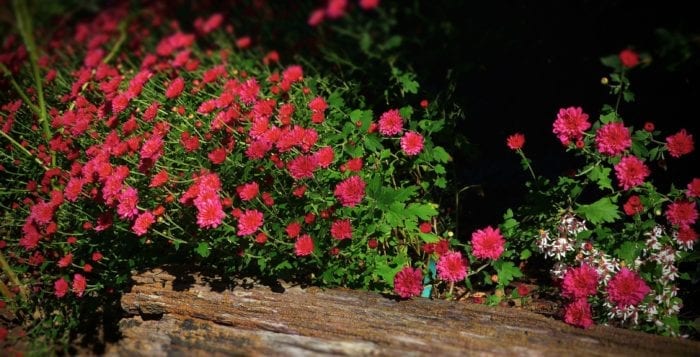The Gardener’s Delight: Late season color for your garden
By Kyrnan Harvey
This year the deer have left our chrysanthemums alone. So far. This is our third year in the Three Villages, and the assumption originally was that aromatic plants are passed over by the white-tailed browsers. Wishful thinking.

Last year, the mums were left alone all summer, until the buds formed on the flower stems, which apparently are a delicacy for discerning deer in the know. This year, we sprayed deer repellent once on the cerise mum near the driveway entrance but none on the ‘Dark Bronze Daisy’ or the unnamed Home Depot orange mum. And who knew? These latter two are a square yard untouched and flowering beautifully for a month already and the cerise one is just now popping.
This morning, while pulling up unwanted goldenrod volunteers, I became reacquainted with a gorgeous white one, very tall and promising in bud now, that I had plucked last year from the florist shelves at the market.
As a garden designer favoring naturalistic plantings, I generally eschew the seasonal mum installations. But I do love the colors; who doesn’t? There are many varieties grown, often two apparently identical colors are actually merely similar colors, subtly different varieties. Usually you will find a small label with a cultivar name on it, like ‘Plumberry Purple’ or ‘Flamingo Pineapple’. Every year one or two colors at Home Depot or Stop&Shop or my myriad wholesale sources catches my fancy. I am often asked “Are they perennial?” “How do you know which ones will come back next year?”

In years past I would answer that the “old-fashioned” single ones, formerly called Korean mums and rarely seen in garden centers, are reliably hardy and perennial. There is a charming single pale apricot must-have called ‘Sheffield Pink’ that is absolutely perennial and that flowers very late. But I am now convinced that the brilliantly colored doubles will naturalize too and need not be regarded as throwaways. I buy just one piece (as the nurserymen say) and find a suitable location for that color.
I cannot account for the gustatory vagaries or the culinary whimsies of our graceful quadripeds, but here is how to get “dem” mums to survive the winter and to increase in girth. Don’t plant them too late and don’t let them dry out.
Don’t buy a pot in September for your front door, neglect to water it three straight sunny 75 degree days, and then not plant it outside until Thanksgiving.
Typically chrysanthemums are root-bound in those green plastic pots. Root-bound means they dry out quickly and watering can’t penetrate the density of roots. The good independent garden centers have staff that know how and how often to water them to keep them from drying out — not so at the box stores. There is a point of no return, if left unwatered for too long. Haven’t we all seen inventories of mums fried and roasting at the edge of the parking lot, wilted to a crisp? It’s okay to decorate the porch for a couple weeks, but put saucers under them and if they’re in the sun err on the side of too much water.

Another common pitfall is to assume that once it is planted and you have thoroughly drenched it, you are done. Not necessarily the case, never more so than the past few weeks when it has been unseasonably warm and it hasn’t rained. We did a large mum installation at a client’s temple for the holidays. No automatic irrigation, and we watered by hose two times a week for a couple weeks. Checked in after a long weekend and sure enough a few of the 70 were wilting. Even where there is automatic irrigation, hand water if there are no good soakings from mother nature.
When planting out your mums, they will want, like most daisies, a sunny spot if your intention is for them to perennialize. Also needed is good, loose soil that’s been dug free of tree roots and soil compaction. Water in well at planting and as necessary for a few weeks, so that they will root in to their new soil. This is the key; this is what determines whether they survive through to next year: Are they established in the garden well before the hard frosts of January? I usually leave the unsightly spent flowers uncut until March. My sense is that these provide insulation from winds to the basal foliage, visible even in a flowering plant, upon which the plants’ future depends.
Of course, you can still plant mums with no expectation that they will provide perennial pleasures. You still have to keep them watered, but you can cram them into crummy builders’ fill under oak trees — as we did at the temple — and do it again next year. But it is really delightful and gratifying to see drifts of sprays of that superb color year in, year out. They actually are carefree and drought tolerant once established. And if the deer one year take a fancy to that color? You’ll live, and next year you will enjoy the show more.
Kyrnan Harvey is a horticulturist and garden designer residing in East Setauket. For more information, visit www.boskygarden.com.
All photos by Kyrnan Harvey







